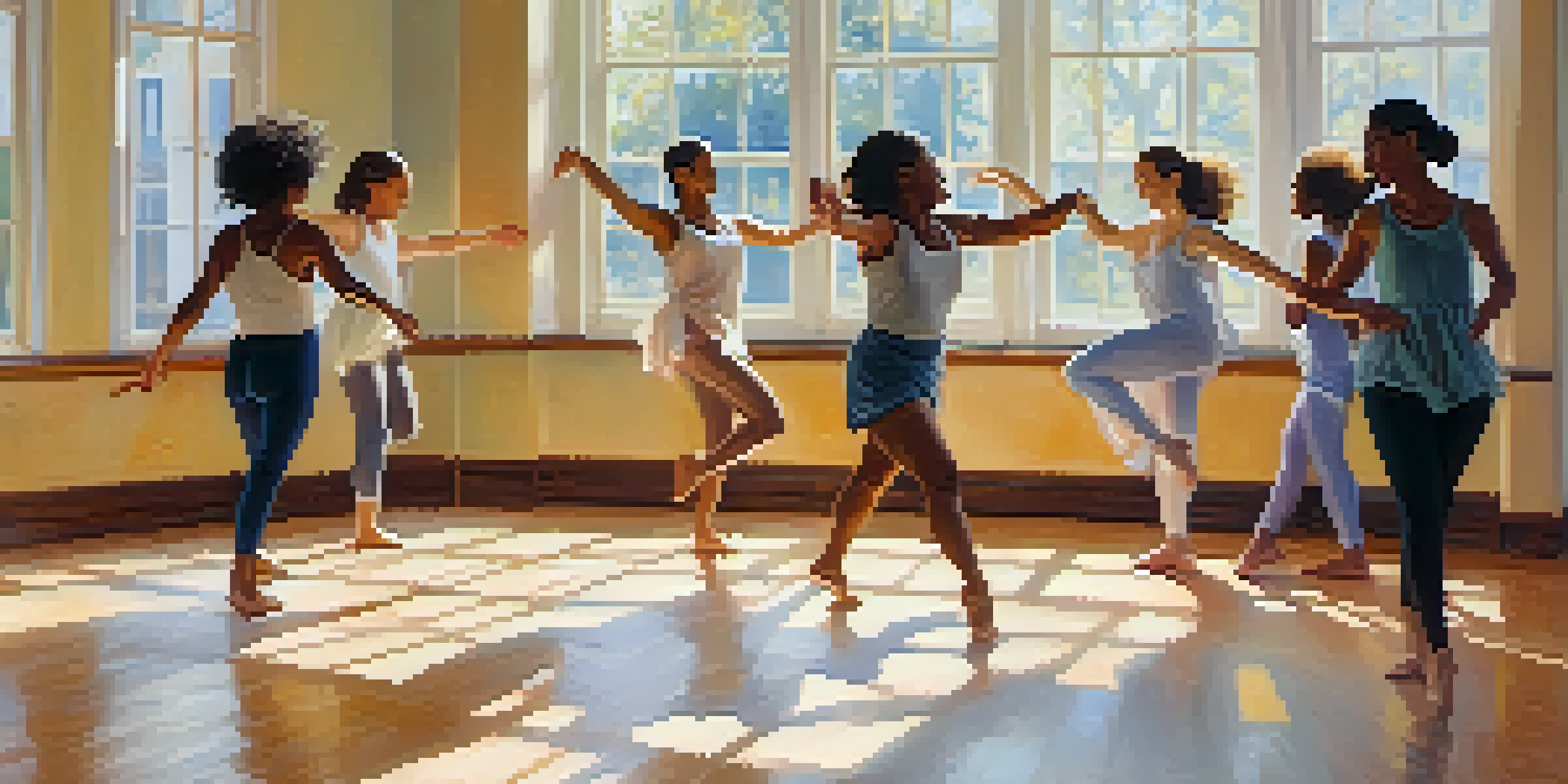How Dance Movement Therapy Improves Mental Health and Emotions

Understanding Dance Movement Therapy and Its Purpose
Dance Movement Therapy (DMT) is a therapeutic approach that uses movement to promote emotional, cognitive, and social integration. It's based on the idea that our emotions are expressed through our bodies, and movement can unlock feelings that words sometimes cannot. In DMT, trained therapists guide individuals in expressing themselves through dance, which can lead to profound insights.
Dance is the hidden language of the soul.
This form of therapy is particularly beneficial for those who struggle to articulate their emotions verbally. By engaging in movement, clients can explore and express feelings in a safe, supportive environment. It's like using paint to express your mood when words fail; the body can communicate what the mind sometimes cannot.
Ultimately, DMT aims to foster a greater connection between mind and body, leading to improved mental health. Whether it’s joy, sadness, or anxiety, movement allows individuals to experience and process their emotions authentically.
The Science Behind Dance and Mental Health
Research has shown that movement can significantly influence our mental well-being. When we dance, our brain releases endorphins, the body's natural mood lifters. This biochemical response can result in feelings of happiness and relaxation, making dance a powerful tool for combating anxiety and depression.

Moreover, engaging in dance movement also enhances brain function. Studies have indicated that physical activity, including dance, stimulates areas of the brain involved in memory, coordination, and emotional regulation. This is akin to giving your brain a workout while simultaneously boosting your mood.
DMT Enhances Emotional Expression
Dance Movement Therapy allows individuals to express and process emotions through movement, providing a holistic avenue for emotional healing.
Thus, the science supports what many have intuitively felt: dance is not just a form of entertainment; it’s a vital contributor to mental health. By integrating movement into therapy, individuals can experience these cognitive and emotional benefits firsthand.
How Dance Movement Therapy Addresses Anxiety
Anxiety can often feel like a heavy weight pressing down on us, making it hard to breathe or move freely. Dance Movement Therapy offers a unique way to release this tension through physical expression. Instead of bottling up feelings, participants are encouraged to channel their anxiety into movement, finding relief and clarity.
The body says what words cannot.
For example, through structured improvisation or guided movements, individuals can express and explore their anxious feelings without fear of judgment. This practice not only provides a physical outlet but also helps in recognizing and understanding the triggers of anxiety. It's like shaking off the cobwebs that cloud your mind.
As a result, DMT can empower individuals to confront their anxiety and develop healthier coping mechanisms. By transforming anxious energy into creative movement, individuals often leave sessions feeling lighter and more at ease.
Building Self-Esteem and Body Acceptance
Dance Movement Therapy fosters a deeper connection to one’s body, which can significantly enhance self-esteem. Many individuals struggle with body image issues, often feeling disconnected from their physical selves. DMT encourages participants to embrace their bodies through movement, celebrating their uniqueness and capabilities.
During sessions, individuals are guided to explore various movements that feel authentic to them. This exploration can lead to a revelation: appreciating what the body can do rather than how it looks. It's similar to discovering a hidden talent; the more you dance, the more you realize your body is a remarkable instrument of expression.
Boosts Self-Esteem and Body Acceptance
By encouraging movement and self-exploration, DMT fosters a deeper connection to one’s body, enhancing self-esteem and body acceptance.
As participants gain confidence in their movements, they often find a newfound sense of self-worth. This boost in self-esteem can ripple into other areas of life, allowing individuals to approach challenges with greater resilience and positivity.
Enhancing Emotional Expression and Regulation
One of the most profound benefits of Dance Movement Therapy is its ability to enhance emotional expression. Many individuals find it challenging to articulate their feelings verbally, but movement provides an alternative avenue for expression. Through dance, clients can explore a range of emotions, from joy to sorrow, allowing for a holistic approach to emotional healing.
In DMT sessions, participants often experience a release of pent-up emotions. It's as if the act of dancing becomes a cathartic experience, enabling individuals to process and let go of feelings that may have been suppressed. This release can be incredibly liberating, akin to a weight lifted off one’s shoulders.
Furthermore, as individuals learn to recognize and express their emotions through movement, they also develop better emotional regulation skills. By understanding their emotional responses, clients can navigate feelings more effectively in their daily lives, leading to improved relationships and overall well-being.
Fostering Social Connections Through Movement
Dance Movement Therapy is often conducted in group settings, providing a unique opportunity for social interaction and connection. In a world where many feel isolated, being part of a DMT group can create a sense of community and belonging. Participants share their movements and experiences, fostering mutual understanding and support.
This group dynamic can be particularly beneficial for those experiencing loneliness or social anxiety. As individuals move together, they learn to communicate through non-verbal cues, building trust and camaraderie. It's like forming a bond through a shared language of movement, where everyone feels seen and accepted.
Fosters Social Connections in Groups
Participating in Dance Movement Therapy in group settings cultivates social bonds and mutual support, enhancing the therapeutic experience.
Ultimately, these social connections can enhance the therapeutic experience, leading to improved mental health outcomes. By engaging in DMT with others, individuals not only heal themselves but also contribute to a supportive community that uplifts everyone involved.
Practical Tips for Getting Started with DMT
If you're interested in exploring Dance Movement Therapy, the first step is to find a qualified therapist who specializes in this approach. Look for someone with a background in dance and movement, as well as training in therapeutic practices. This ensures that you receive the guidance and support needed to navigate your emotional journey safely.
Before attending your first session, it may be helpful to reflect on what you hope to achieve through DMT. Are you looking to release anxiety, improve self-esteem, or simply find a joyful way to express yourself? Setting intentions can create a more focused and meaningful experience.

Lastly, keep an open mind and be patient with yourself. DMT is a personal journey, and everyone's experience will be unique. Allow yourself the freedom to explore movement without judgment, and you may find that the process is just as rewarding as the outcome.